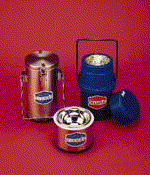Liquid Nitrogen Safety
See rules from:
- Oak Ridge rules
- OMRL
- NOAO
Calculate how much LN2 is necessary to displace all your air.
- General precautions for all use of LN2 (liquid nitrogen)
-
At all times, HAVE A PLAN of what you will do if...
-
A pressurized Dewar spontaneously vents?
-
You freeze your watchband or wedding band to your finger?
-
The funnel (which you should not be using) freezes and spews nitrogen upward into your face?
-
160 L of LN2 for whatever reason falls onto its side? (It happens. It's scary and unpleasant and could easily be quite disastrous.)
-
-
Liquid nitrogen can cause terrible "burns." (Death of living tissue caused by the extreme cold.) Hand protection and goggles (not safety glasses) are to be worn when dispensing and handling liquid nitrogen. When handling large quantities, a full length apron will minimize the chance of a spill going into your shoes, where it might destroy some cubic centimeters of flesh before you can get your shoes and socks off. Persons using a tipper to dispense LN2 must wear a full face shieldover goggles, cryo-gloves, full length cuffless trousers which completely cover the tops of the shoes (or a full length apron), and shoes which will not permit liqufied gas to enter them in case of a spill, and which are also quickly removable in case they do (allow liquid to enter).
-
Do not use a funnel.
-
Do not store container(s) of LN2 in a cold room or any other location where a person could physically enter an anoxic atmosphere. (Cold rooms have no air changes and a person entering a room with elevated nitrogen in the air can quickly pass out and then die within several minutes of entering.
-

Liquid nitrogen will condense oxygen from the air. This is most alarmingly demonstrated if a person leaves his/her vacuum pump's coldfinger in a Dewar of liquid nitrogen overnight. In the morning the coldfinger will contain LIQUID OXYGEN up to the level of the nitrogen in the Dewar.
-
Guard against pressure build-up by using a pressure relief vessel or a venting lid.
-
Remove metal jewelry/watches on hand and wrists.
-
Glass Dewars must be taped solidly around the outside. The plastic mesh with which some small thermoses are sold protects the Dewar itself to some extent, but does not protect very well against injury from glass shards resulting from implosion.
-
Asphyxiation -- nitrogen is not poisonous; the air is already about 78% nitrogen (oxygen makes up about 21%, and trace gases the remaining 1%). However, if sufficient liquid nitrogen is vaporized so as to reduce the oxygen percentage to below 19.5%, you are at risk of oxygen deprivation. Rapid venting can cause near-total displacement of normal air, leading to a local concentration of about 100% nitrogen. Simple asphyxiants such as nitrogendo not have good warning properties! (You might not feel "light-headed," you may simply pass out without any warning whatsoever. And then die without regaining consciousness.)
-
Use only vessels designed for extreme cold. Not all Dewars are rated for liquid nitrogen. Always follow manufacturers' guidelines for use of cryogen vessels of any size.
-
Do not carry liquid nitrogen in a passenger elevator.
-
Never work alone with hazards, always have at minimum two people moving a large Dewar in hallways, elevators, and outside of buildings.
-
Cryotubes containing samples stored under liquid nitrogen may explode without warning. Tube explosions are thought to be caused by liquid nitrogen entering the tube through minute cracks and then expanding rapidly as the tube thaws. Serious accidents have occurred around the country due to tube failures. A researcher in California lost an eye; numerous others have suffered plastic shards embedded in their hands and faces.
-
- Dispensing from stationary bulk storage tank (outside, at east end of BRWN) into large mobile dispensing Dewar.
-
This operation is to be performed only by trained department staff. Contact the Safety Director.
-
- Dispensing from large dispensing Dewar near BRWN 1180 dock. (Also see general precautions above.)
-
Nitrogen is to be dispensed only into smaller Dewars which either (a) have carrying handles or (b) are on wheels or (c) are 500 mL or smaller,andwhich have pressure relief valves or pressure venting lids. A wide-base Dewarwhich is stableon a wheeled cart qualifies as "on wheels."
-
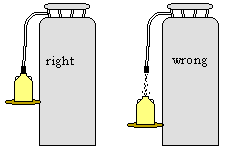 Persons filling must be in constant attendance to the filling operation.
Persons filling must be in constant attendance to the filling operation. -
If the receiving vessel is small enough to be placed on the adjustable table, adjust the table so that the delivery is immediately at the mouth of the receiving vessel. (I.e., do not allow the liquid nitrogen to fall through a distance to reach the receiving vessel.) If the vessel is too large for the table, or the table is missing or inoperable, other provisions must be made for safely raising the vessel up to the delivery tube.
-
Do not hold the vessel with unprotected hands while filling.
-
Do NOT move/bend the copper fill tube. It causes wear that will eventually cause the tube to break.
-
Persons filling Dewars should wear full length non-cuffed trousers (covering tops of shoes) or full length apron, and shoes which will not admit spilled cryogen and which are easy to remove quickly. Also wear goggles and cryo-gloves.
-
- Transporting by hand or cart through a building or between buildings.
-
Large mobile Dewars used for transport:
-
should be equipped with a braking mechanism. Do not use feet to brake.
-
steel toed boots are recommended.
-
take care to avoid crushing hands or fingers between the vessel or cart and walls or door frames.
-
if there is any risk of tipping, a cart should be used. Wheeled trolleys may not be used if the vessel must pass over elevator thresholds or other slots/crevasses wider than 25% of the wheel width.
-
-
For transport of large nitrogen Dewars outside -- over pavement, sidewalks, wheelchair curb-cuts... -- a 4-wheel tipcart should be used. The casters welded to the tank, and/or the casters on the trollies in common use, are not meant for transport over pavement and concrete. While enroute, excercise great care stay completely clear of sewer grates, large cracks, and/or uneven portions of the pavement, and any other hazards which could catch a cart wheel and cause tipping.
-
Inside buildings, from room to room, the best transport is by Dewars which either have carrying handles (4 L and less) or are on wheels (larger Dewars), and which have pressure relief valves or pressure venting lids. (A wide-base Dewarwhich is stableon a wheeled cart qualifies as "on wheels.")
-
For short distances in hallways it is acceptable to hand-carry a pint (~ 500 mL) or smaller Dewar of nitrogenwhich has no handles, if and only if
-
the Dewar is your only load (no books, no coffee, no other items), and
-
the vessel has a venting lid (a cork or loose stopper is fine), and
-
you are carefully watching for people who will run into you, and
-
the vessel is carried with both hands and as far away from your face as comfortably possible.
-
-
Dewars: Examples of liquid nitrogen vessels; all are frequently referred to as "Dewars."
|
Item |
Description |
|---|---|
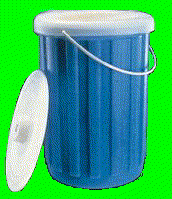 |
Dewar Flask HDPE 1 Litre about $100 Also in 2 and 4 L with handle. OK for temperatures from -196 to 100C |
|
|
|
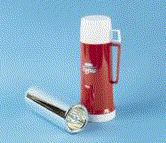 |
Dewar flask cylindrical silvered borosilicate glass 375mL about $60 |
|
|
FisherBrand Metal-Cased cylindrical, in various sizes from 0.75 qt to 4.5 qt, with and without handle, $90 - $240 |
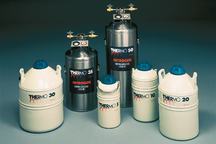 |
From catalogue text: "Provide safe and efficient storage and handling of liquid nitrogen. Lightweight design makes them ideal for everyday laboratory use. Narrow neck and vacuum insulation keep evaporation rates low. Durable aluminum, double-wall construction ensures years of trouble-free service even with the rough handling associated with portable cryogenic equipment. Pail-style handle on the Thermo 5 and 10 makes pouring easy even in hard-to-reach places. Thermo 20 and 30 offer the same lightweight design and low liquid nitrogen consumption rate in a larger Dewar. Thermo 35 and 50 are pressurized cylinders designed for researchers who need a continuous source of liquid nitrogen but lack space for larger cylinders. Relief valve setting on the 35- and 50-liter models is 22psi. About $1000 for the 30 L model." |
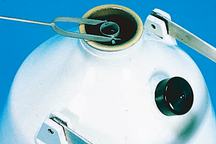 |
Dipper, 12 mL, for removing nitrogen from the Dewar. |
|
El-cheapo - the plastic mesh covered version with no handle. Borosilicate glass. Metal casing surrounds only bottom portion of flask. Protective plastic mesh covers remaining outer surface of glass. Special vented polyethylene stopper minimizes evaporation and potential for splashing when moving (If you use it.). $67 - 205 for 665 mL - 4300 mL sizes |
|
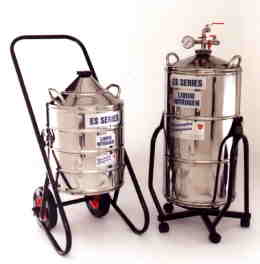 |
25, 35 and 50 L capacities available With static evaporation rates as low as 0.7L/24h photo shows ES-25 & ES-50 dewars with optional pouring trolley, tipping stand & 50KF dispensing head, from CRYOTECHNICS. Albion Industrial Estate,78 Albion Road,Edinburgh. EH7 5QZ. UK. |
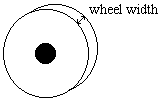
This upright tank is a stainless steel 180 L self pressurizing vessel which is used to store, fill & dispense liquid nitrogen to storage refrigerators or other containers, Wheels such as shown here are acceptable for transport across inner hallways surfaces, elevator thresholds, or onto scales if the wheels are 3" diameter or greater and the wheel width is larger than the gaps over which the vessel must travel. |
